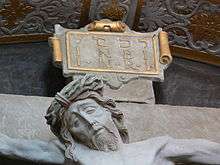Quod scripsi, scripsi

Quod scripsi, scripsi (Latin for "What I have written, I have written") is a Latin phrase. It was most famously used by Pontius Pilate in the Bible in response to the Jewish priests who objected to his writing on the sign (titulus) that was hung above Jesus at his Crucifixion. It is mostly found in the Latin Vulgate Bible.[1]

History
The phrase appears in the Bible in John 19:20–22. When Jesus was sent to be crucified, Pilate wrote the sign to be hung above Jesus on the cross. He wrote "Jesus the Nazarene, King of the Jews" in Hebrew (or, more correctly, Aramaic[2]), Latin and Greek. The Jewish priests voiced their objections of this to Pilate, stating that Jesus had only claimed the title and they did not recognise Him as such. They said to Pilate "Do not write King of the Jews".[3] Pilate responded to them sternly with "Quod scripsi, scripsi" which was interpreted by Jerome as an allusion to the headings of Psalm 56 and Psalm 57, which in the Vulgate seem to refer to an inscription that is not to be changed.[4][3]
The scene where Pilate says "Quod scripsi, scripsi" was not covered in art or discussion as a popular subject. Aside of the Bury St. Edmunds Cross there was little discussion on it in the pre-Reformation Christian Church. It was suggested that this may have been because it is only mentioned in detail by St. John the Evangelist and because it was mentioned in the apocryphal Acts of Pilate.[4]
Other uses
In 1306, when Henry II of Jerusalem signed a patent to give the Kingdom of Cyprus to the governorship of Amalric, Prince of Tyre, the Marshal of the Temple accompanying Amalric reportedly said "Quod scripsi, scripsi" with disdain to Henry when he signed the patent.[5]
The philosopher Immanuel Kant used a play on "Quod scripsi, scripsi" in response to critics of his Metaphysics of Morals, using "Quod scripsi, scribentes" (What I have written, I am writing).[6]
In the shared alternate history of Ill Bethisad (1997 and after), "Quod scripsi, scripsi" (often shortened to "QSS") is the term used for one of the rules or "Five Pillars" of the alternate timeline.[7] "Quod scripsi, scripsi" in this sense means that once something has been established into the timeline, it cannot be changed or removed.[8]
José Saramago started his 1991 novel The Gospel According to Jesus Christ with this quote, both as a reference to Pilate's writing, but also as an answer to the criticism he anticipated.
References
- ↑ "The Cloisters Cross". The Metropolitan Museum of Art. Retrieved 2014-03-18.
- ↑ The HarperCollins Study Bible, New Revised Standard Version, ISBN 0-06-065580-1, page 2051
- 1 2 Brown, Raymond Edward (1988). The Gospel and Epistles of John. p. 93. ISBN 0-8146-1283-0.
- 1 2 Longland, Sabrina. "Pilate answered "What I have written, I have written"" (PDF). The Metropolitan Museum of Art. Retrieved 2014-03-18.
- ↑ Hill, George (2010). A History of Cyprus, Volume 2 (reprint ed.). Cambridge University Press. p. 230. ISBN 1108020631.
- ↑ Baumgarten, Alexander (2013). Metaphysics: A Critical Translation with Kant's Elucidations, Selected Notes, and Related Materials. p. 76. ISBN 1441132945.
- ↑ "How It All Works", Ill Bethisad Wiki
- ↑ "QSS", , Ill Bethisad Wiki